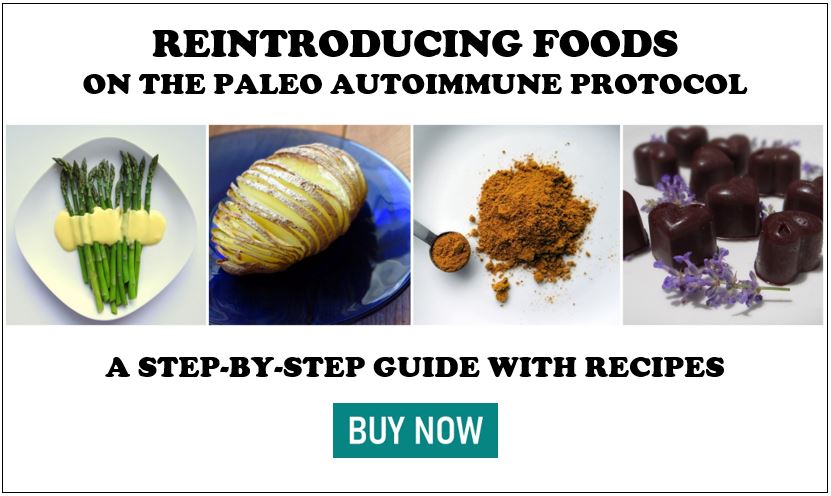“Knowing yourself is the beginning of all wisdom.”
~ Aristotle
A New Series
Reintroducing Foods on the Paleo Autoimmune Protocol was my first e-book, which I published back in 2014. I realized that the reintroduction process is often the trickiest part of the AIP journey. It can be confusing, overwhelming, and hard to navigate alone. I wrote the book to guide people through, and thereafter got a nickname: Reintro Goddess. (Just kidding, but wouldn’t that be a great nickname?) I’m passionate about this process for two reasons: (1) Some people make the mistake of thinking the elimination phase of the AIP is meant to last forever. It’s not. It’s just the first step. The next step is personalizing the diet for you. (2) The reintroduction process is an experiment with you at the center, where you learn to communicate clearly with your body, and it’s incredibly empowering! Everyone’s reintroduction experience is unique. I thought it would be inspiring and educational to interview people who have been through this process themselves. This is the first of many such interviews, which I plan to share here on my blog.
Introducing Samantha McClellan
Samantha has ulcerative colitis, and the paleo autoimmune protocol has been an essential part of her healing journey. The cutie patootie in the photo is her daughter, affectionately dubbed #babysweetpotato on her Instagram feed.
- How long did you do the elimination phase? 6 Months
- What foods have you been able to successfully reintroduce? Green beans, seed based spices, ghee, egg yolks, chocolate (soy and dairy free), alcohol (mostly wine, some hard cider if it is low in sugar, and tequila), almonds, macadamia nuts and pecans. I also did partial reintroductions of white rice and goat cheese during pregnancy.
- Which ones can you eat regularly and which ones just occasionally? How did you discern the difference? Most of my reintroductions, with the exception of alcohol and the two pregnancy reintroductions, I can eat as often as I want without issue. I obviously have to watch the chocolate consumption because of the sugar, but it doesn’t give me any real issues. I can only tolerate about one drink of alcohol a week most of the time. If I am on vacation and relaxed, I may be able to have two or three drinks in a week but I have to be careful. The goat cheese and white rice were foods that I added back into my diet towards the beginnings of my last two pregnancies as a means of combating nausea and lack of appetite. They did slow down my digestion though, so I removed them once I started feeling better, and they are not regular parts of my diet. I discerned the difference in how often to eat reintroduced foods by just paying close attention to how I feel. I know that on elimination AIP I feel good and my digestion functions well, so if I start eating something new more regularly it is easy to tell that that is the issue. Eileen’s Editorial Note: The Paleo AIP Reintroduction Guide includes a 2-phase process that helps people notice this difference before it becomes a problem.
- When food reintroductions failed, what were your symptoms? My two big failed reintroductions have been coffee and egg whites. With coffee, my ulcerative colitis symptoms would return fully within about 24 hours after drinking just one cup, regardless of how it was prepared or how high-quality the coffee. With egg whites, I had severe stomach cramps unlike anything else I have experienced, within a few hours of eating them.
- Did any reintroduction failures later become successes? Nope, I have taken the reintroduction process very slowly, because I have experienced a lot of external life stress and transitions in my years since starting AIP. There haven’t been many times where I felt like I could physically handle a failed reintroduction. That being said, I tried reintroducing coffee three times before giving up entirely, and I do plan to try egg whites again in the future.
- Have you reintroduced any non-paleo foods? If yes, which ones and how often do you eat them? Only during the beginning stages of pregnancy, and only goat cheese and white rice.
- Is there any food you’d never reintroduce? I don’t have any plans to reintroduce nightshades any time soon. At my sickest, I was following a regular (non-AIP) paleo/primal diet template. Based on the foods that I have reintroduced so far, it is fairly clear to me that my biggest trigger foods were/are egg whites, coffee and nightshades, because those were the foods that I was eating a lot of at that time that I don’t eat now. Plus, I am so used to avoiding nightshades that it doesn’t really bother me to exclude them for the time being.
- What affects your food tolerance? Stress and sleep have a huge impact. I already talked about how being on vacation impacts my ability to tolerate alcohol. When I am flaring I remove chocolate, almonds and alcohol entirely, since they don’t really contribute to my healing and it is easy for me to get carried away with them.
- Have you ever done an AIP reset (where you did the elimination phase over again)? If yes, what was the motivation, and did you find it helpful? Yes, I do an AIP reset when I flare, although I don’t always do it for a full 30 days. Often I do a full elimination phase for about a week, and then I add back in some of the nutrient-dense reintroductions that I know I tolerate well like egg yolks, ghee, and green beans. I do find it helpful. It calms down my system and also brings me back to focusing on nutrient density. That’s especially helpful if I have started to get into a rut with my food choices.
- Are there any foods allowed on the AIP that you discovered you don’t tolerate? If yes, how did you figure it out, and did this intolerance improve over time? Yes, I found out that I am oddly allergic to canned fish. I am still not 100% sure why I can’t tolerate it, but I started eating a lot of wild-caught canned salmon at one point. It’s supposed to be one of the cheapest and most nutrient-dense options, and I got terribly ill and started having migraines. It took me about a week to realize that it was the fish that was causing them. I haven’t tried it since then; I just stick with fresh or frozen fish instead.
- What was the hardest part for you about the reintroduction process? The anxiety. My flares often take a month or more to resolve completely, so the thought of voluntarily doing something that could trigger a flare is hard for me.
- What’s your advice for people contemplating reintros, or just starting their own reintroduction journey? My advice would be to take your time and do them correctly, introducing one food at a time and waiting the recommended amount of time in between. You have put so much hard work and dedication into the elimination phase, you want to make sure that you get an accurate response from your body and get the personalized information that is really with the autoimmune protocol is all about.
One Last Word of Advice
Each person’s food reintroductions are unique, so don’t expect your results to be the same as above, even if you share the diagnosis. It’s fun to learn about each other’s experiences and be encouraged by them, but this is all about learning to listen to your own body. Use the resources below to learn how to do the reintroduction process yourself.
Paleo AIP Reintroduction Resources











I’m currently on around Day 21 of the autoimmune protocol diet, so you can imagine that I have been feverishly searching for reintroduction stories and how people have fared! I was diagnosed with rheumatoid arthritis when I was 17, and now at 24, I’m finally taking control of an area of my life that I really didn’t want to admit was a cause for concern, my diet. It’s hard to find people of a similar age who are going through the same things, so these stories from people around the world is very interesting and somewhat soothing to read!
So far, all my arthritic pain has gone, my energy levels are high and I feel really good! I’m so happy to have finally taken the plunge with the AIP diet! I’ve just started to track my journey on my blog: http://mikaelabartlett.com/ – so I can look back and see where my mind was at when doing this diet 🙂 Great post!
Welcome to the AIP community, Mikaela! If you haven’t already listened, the following podcast might resonate with you as well: Episode 16: Young, Single & AIP.
I was very happy to find this post. I was diagnosed with lymphocytic colitis (a form of microscopic colitis thought to be an autoimmune issue) and told to eat gluten free to keep it under control. Unfortunately, that wasn’t completely successful. So, since I have had to deal with a couple of other fairly rare autoimmune issues (pars planitis and autoimmune pancreatitis), I decided to give the AIP a try. I feel wonderful! I am losing weight, have energy, the brain fog is gone…. but the lymphocytic colitis will not get under control. I am at a loss for what to do next. Hopefully my gastro doctor will have some ideas because this approach to eating is making me feel better than I have in ages.
Hi Sheri. I’m so glad you are feeling so much better on the AIP in other ways. That’s a very good sign. I don’t know if you’re on medication, but sometimes the combination of meds + diet/lifestyle is what’s needed. I also recommend listening to podcast 83 if you haven’t already. It’s all about the AIP for IBD: http://www.phoenixhelix.com/2017/11/11/episode-83-medical-study-on-the-paleo-aip-for-inflammatory-bowel-disease/
I always enjoy reading about others AIP roadblocks and journeys. And I am mostly always surprised by them too. What I learned from this interview is the connection between “emotions” and reintrod foods. I had not yet realized that fact at a higher level yet and wil think on this a while. (I know that going to much/not enough daytime rest really plays havic with my emotions even more so than foods.) I now eat 100% organic and GMO free foods which I think might help me at many levels including with reintroductions. I am one of the lucky ones who does not have pain with my Autoimmune Hashimotos. This is fortunate on many levels but it also makes knowing when one is having trouble with foods and reintros’. I don’t have many physician symptoms with “forbidden” type foods (except GERD at night as my main physical symptom.) So it just makes this process all a bit more tricky for me personally. I seem to be able to eat almost anything within limits (like once or twice a week without any real issues – even ancient grains spelt English muffins as long as not eaten too often) I am two+ years into elimination and yes, I am nervous about the reintroduction phase. I have reintrod herbs, spices, eggs, wild/brown rice a few others and am now trying tomatoes as an accent now (like my homegrown tomatoes on top of a baked chicken and in the bone broth-not eating a fresh whole tomato.) You are writing this series for people just like me!! The only ” no no” for me seems to be green beans, though I do plan to try them again in the future maybe next summer when they are super fresh fro the garden. I have not reintros nightshades and may not ever do those. Have just read about too many issues with nightshades to be comfortable now.
Hi Donna. That’s wonderful that you can eat such a wide variety of foods as long as you don’t eat too much. It sounds like you’ve done wonderfully with your reintro. journey. Some people are able to enjoy a wider food tolerance than others, and it’s something to celebrate. A couple of tips: (1) Tomatoes are a nightshade, so if you did well with those, you can explore other foods in that category as well. Just take them one at a time and move slowly, as you’ve done with your other reintro experiments. (2) There are also a wide variety of ways your body can communicate food intolerance beyond pain. Digestive issues (like the GERD you mentioned), rashes, moodiness, fatigue, headaches, insomnia, etc. Basically anything outside of your norm.
Re-introductions were a real issue for me too. Thanks for this.
You’re so welcome!